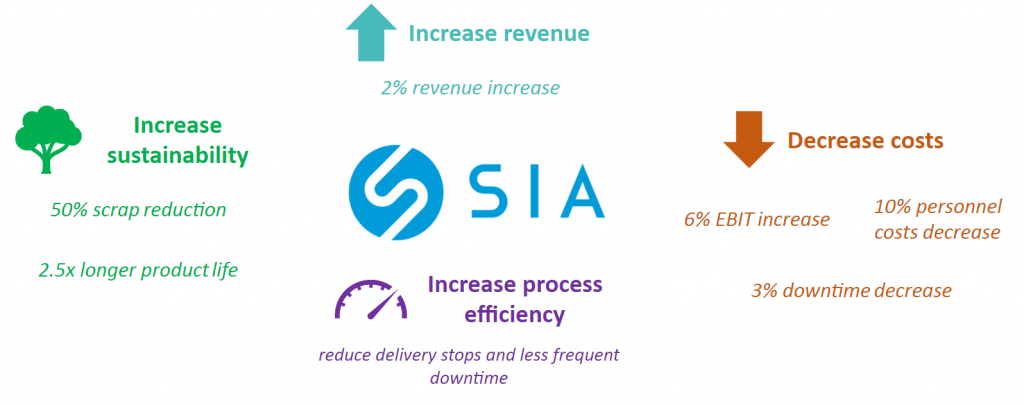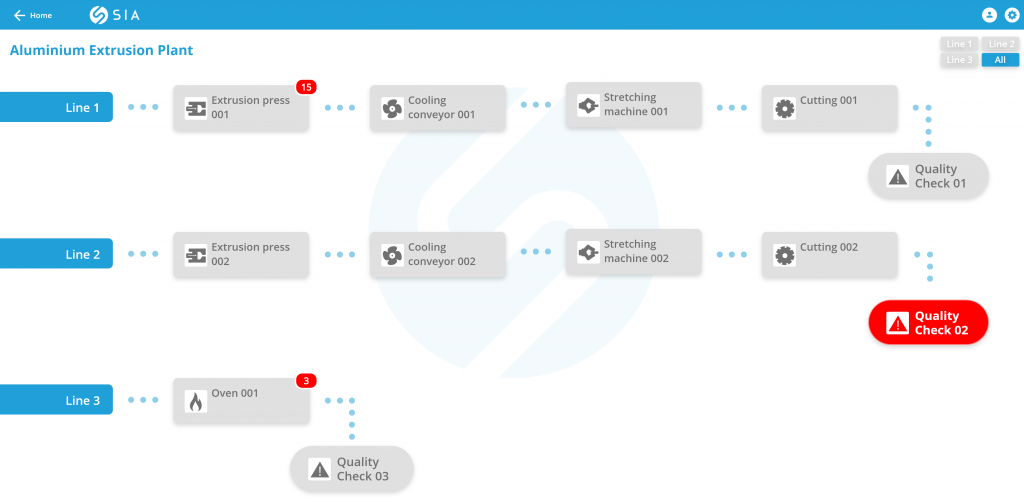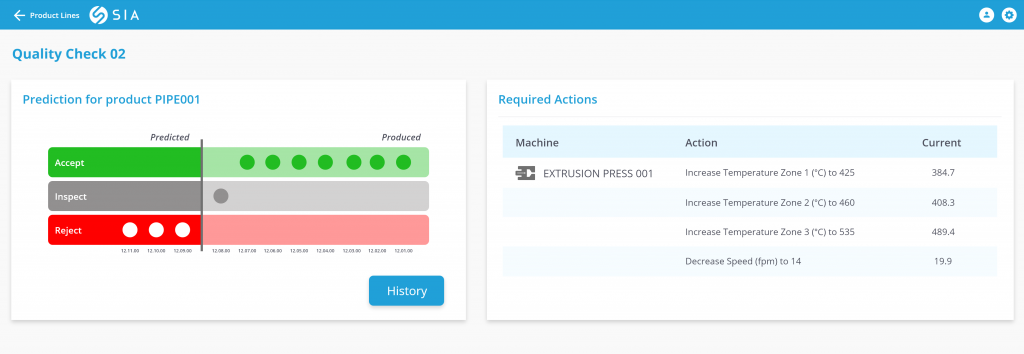How to realize the promises of Industry 4.0
Understand and control the behaviour of your processes and machines
Industry 4.0 is the latest industrial revolution and is rapidly transforming the industrial landscape. It is mainly concerned with increased integration of “cyber physical systems” into the manufacturing processes. This can be understood as the integration between the manufacturing operations systems and information and communication technologies (ICT). Technological developments, such as Internet-of-Things (IoT), increase the availability of product- and process data. Consequently, this brings along the opportunity to gain data-driven insights for both products and processes.
Market Trends
Forbes published that the main benefits of Industrial Data Analytics as perceived by the industrial companies come down to increased revenue, increased customer satisfaction and increased product quality[i]. The technologies that play a role in obtaining these benefits are expected to change, where advanced analytics platforms, predictive analytics tools, and artificial intelligence will become increasingly important[ii] (Fig 1).
This transformation fuels related markets, such as that of Artificial Intelligence (27% CAGR until 2025)[iii]. However, compared to other domains, such as marketing and sales, the manufacturing domain is least impacted over the past three years. [iv] This may imply that there are still numerous opportunities for improvement. McKinsey & Company estimates that the digital revolution can increase revenue growth and margins in the manufacturing domain both up to about 10%.[v]

Figure 1 Key technologies according to industrial companies to benefit from Industrial data
Interestingly, probably all companies stress the importance of digital transformation, from which nowadays most companies embed a digital aspect in their long-term strategy. However, only a few are capable of implementing their digital strategy into their organizations’ daily operations. These digital leaders leverage the benefits to gain competitive advantages and strengthen their market position, whereas all others have to pull out all the stops to follow their trace. It sometimes seems as if the majority of the companies doesn’t urge to put their digital strategy into practice or lack the knowledge or resources to do so.
As described above, there is substantial traction in today’s digital market. Whereas companies used to process some but limited data to describe the past performance using tools such as Microsoft Excel or ERP systems, companies increasingly seek to adopt more advanced data analytics techniques to leverage their availability of data. The underlying reason for this is to realise a shift from hindsight (“what happened?”) towards insight (“why did it happen?”), and foresight (“what will happen?”). Some large software providers, such as Siemens MindSphere, IBM Watson and GE Predix, offer a platform to implement these advanced data analytics techniques. However, although the included tools in these platforms may help to improve insights, significant data science knowledge and manual effort is required to establish these insights, let alone to make them actionable.
“The barriers to success are dependency on data science knowledge, retrieving actionable information, and robust yet scalable solutions”

Figure 2 Selection of benefits achieved by SIA
Barriers to success
Consequently, the current market offerings still bring some challenges to the table. First of all, companies that want to use these platforms still require data scientists that are able to the build the desired algorithms, and in the current market, data scientists are scarce. Once a data analytics platform is in place, companies possessing Big Data are often overwhelmed with the unlimited opportunities and start to build algorithms without a predefined purpose. Although randomly deploying algorithms at the data may result in interesting insights, it often does not yield actionable information that can directly improve manufacturing processes. Finally, in case companies managed to design algorithms that provide actionable information, many struggle on how to deploy this into operation most efficiently. Is the designed solution, for instance, repeatable over time, or scalable to other production lines?
“SIA is an easy-to-use SaaS tool that extracts value out of data in order to increase profitability, sustainability and quality of products”
The Smart Industry Assistant
Overcoming these barriers may seem hard, but there are now alternatives that enable the benefits of data science to everyone. One of them is the Smart Industry Assistant (SIA).
SIA helps customers to embrace Industry 4.0 and leverage the according benefits in order to improve profitability, sustainability and quality of products and processes (Fig 2).
SIA provides data driven insights in the processes, allowing for objective management and real-time process improvement. By offering advanced data science knowledge “as-a-service”, SIA can add value to any customers, irrespective of the amount of data available. It makes SIA an “plug-and-play”-tool that is extremely easy to use and does not require data scientists for either implementation or operation. In addition, SIA is an affordable and scalable solution, which allows for incremental implementation and ultimately, a “Smart Factory”.
How does SIA work?
After implementation, SIA retrieves and merges the data from all available relevant sources included in the current infrastructure. The gathered data is pre-processed and analysed to determine the key parameters and autonomously predicts the future states of the product or process. The results of the data analysis are continuously visualized on a user-friendly interface (from operator level to management), enabling real-time monitoring of the process and timely intervention in case of product and/or process deviations (Fig 3).

Figure 3 Working of SIA in 3 steps
What is SIA?
SIA is an artificial intelligence service that aims to improve products or production processes in the manufacturing domain. SIA is comprised of six modules, including Anomaly & Pattern Detection, Product Quality Control & Prediction, Monitoring & Reporting, Process Mining, Smart Maintenance, and Process Flow Optimization & Automation (Fig 4). The different modules enable to support clients with a variety of data science related problems. Although the modules are standardized for easy and quick implementation, there is a possibility to create tailor-made solutions.

Figure 4 Available modules in SIA
A SIA Use Case
To illustrate, SIA’s Product Quality Control & Prediction module is recently implemented to improve an aluminium extrusion process. The process exists of five stages, including extrusion, cooling,
stretching, cutting and ageing. After cutting, a manual inspection is performed to guarantee product quality. First, the relevant data from each production stage is collected from the various sensors. The algorithms analyse the retrieved data and autonomously select the parameters that are critical to quality. These parameters are monitored and their values are used to predict the future quality of end-products. If the process operates smoothly, and predicted product quality is as desired, the interface shows the process without error messages. If the future quality is predicted as insufficient, the interface directly notifies the operators with error messages (Fig 5).

Figure 5 SIA enables timely interventions with real-time prioritized warnings & concrete actions
The error message provides more detailed information about the content of the error, and recommends an actionable solution, such that timely intervention can prevent the products from being scrapped (Fig 6).
For this specific use case, implementation at only one production line resulted into a scrap reduction of 50% and an EBIT increase of 6%. As there are many similar production lines, there is significant additional potential for further optimization.
Conclusion
The need to extract value out of data is increasing and cannot longer be questioned. The real question is where, how and what to deploy. Finding the answers to these questions is essential for the long-term profitability of any manufacturing company.

Figure 6 SIA provides actionable recommendations and enables root-cause analysis
[i],2 Source: Forbes 2016 (https://www.forbes.com/sites/louiscolumbus/2016/12/03/industrial-analytics-based-on-internet-of-things-will-revolutionize-manufacturing/#7f1bef196c03)
[iii] Source: Grand View Research 2017 (https://www.grandviewresearch.com/industry-analysis/artificial-intelligence-ai-market),
[iv] Source: McKinsey 2018 (https://www.mckinsey.com/~/media/McKinsey/Business%20Functions/McKinsey%20Analytics/Our%20Insights/Analytics%20comes%20of%20age/Analytics-comes-of-age.ashx)
[v] Source: McKinsey 2019 – how the digital performance (https://www.mckinsey.com/business-functions/digital-mckinsey/our-insights/the-trillion-dollar-opportunity-for-the-industrial-sector)